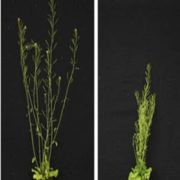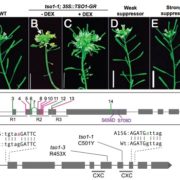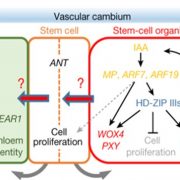APETALA2 coordinates shoot apical meristem shape and identity during floral transition
 The study by Bertran Garcia de Olalla et al. investigated the role of the APETALA2 (AP2) transcription factor in Arabidopsis, particularly its influence on the shoot apical meristem (SAM) during the transition from vegetative to reproductive growth. AP2 is essential for the rapid increase in SAM height and width, which is associated with changes in the central zone and organizing center. As the floral transition progresses, AP2 expression decreases, regulated in part by the gene SUPPRESSOR OF OVEREXPRESSION OF CONSTANS1 (SOC1) and the microRNA miR172. The study highlights the mutual repression between AP2 and SOC1, which plays a crucial role in synchronizing changes in SAM morphology with the plant’s transition to flower production. AP2’s presence in the SAM is essential for establishing and maintaining the characteristic domed shape of the SAM during the floral transition. Moreover, prolonging AP2 expression beyond its typical repression point results in wider SAMs, whereas SOC1 not only promotes the floral transition but also modulates SAM size by reducing both its width and height when overexpressed. The study also shows that AP2 influences cell number and size within the SAM, further contributing to its overall morphology. These findings reveal the gene networks that control the timing and execution of flowering in response to environmental signals. (Summary by Amarachi Ezeoke) Nature Comms. 10.1038/s41467-024-51341-6
The study by Bertran Garcia de Olalla et al. investigated the role of the APETALA2 (AP2) transcription factor in Arabidopsis, particularly its influence on the shoot apical meristem (SAM) during the transition from vegetative to reproductive growth. AP2 is essential for the rapid increase in SAM height and width, which is associated with changes in the central zone and organizing center. As the floral transition progresses, AP2 expression decreases, regulated in part by the gene SUPPRESSOR OF OVEREXPRESSION OF CONSTANS1 (SOC1) and the microRNA miR172. The study highlights the mutual repression between AP2 and SOC1, which plays a crucial role in synchronizing changes in SAM morphology with the plant’s transition to flower production. AP2’s presence in the SAM is essential for establishing and maintaining the characteristic domed shape of the SAM during the floral transition. Moreover, prolonging AP2 expression beyond its typical repression point results in wider SAMs, whereas SOC1 not only promotes the floral transition but also modulates SAM size by reducing both its width and height when overexpressed. The study also shows that AP2 influences cell number and size within the SAM, further contributing to its overall morphology. These findings reveal the gene networks that control the timing and execution of flowering in response to environmental signals. (Summary by Amarachi Ezeoke) Nature Comms. 10.1038/s41467-024-51341-6










